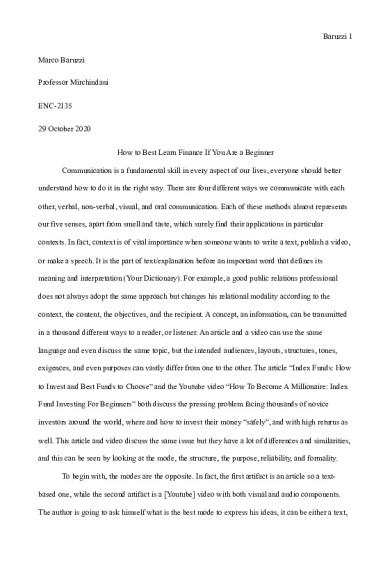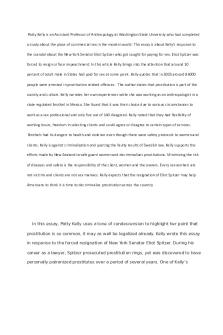Project 2, Rhetorical Analysis of 2 Artifacts - Marco Baruzzi PDF

| Title | Project 2, Rhetorical Analysis of 2 Artifacts - Marco Baruzzi |
|---|---|
| Author | marco baruzzi |
| Course | English Composition |
| Institution | Florida State University |
| Pages | 5 |
| File Size | 132.7 KB |
| File Type | |
| Total Downloads | 101 |
| Total Views | 128 |
Summary
The task was to compare and contrast 2 different artifacts, one video, and one written source, in a rhetorical manner. ...
Description
Baruzzi 1 Marco Baruzzi Professor Mirchindani ENC-2135 29 October 2020 How to Best Learn Finance If You Are a Beginner Communication is a fundamental skill in every aspect of our lives, everyone should better understand how to do it in the right way. There are four different ways we communicate with each other, verbal, non-verbal, visual, and oral communication. Each of these methods almost represents our five senses, apart from smell and taste, which surely find their applications in particular contexts. In fact, context is of vital importance when someone wants to write a text, publish a video, or make a speech. It is the part of text/explanation before an important word that defines its meaning and interpretation (Your Dictionary). For example, a good public relations professional does not always adopt the same approach but changes his relational modality according to the context, the content, the objectives, and the recipient. A concept, an information, can be transmitted in a thousand different ways to a reader, or listener. An article and a video can use the same language and even discuss the same topic, but the intended audiences, layouts, structures, tones, exigences, and even purposes can vastly differ from one to the other. The article “Index Funds: How to Invest and Best Funds to Choose” and the Youtube video “How To Become A Millionaire: Index Fund Investing For Beginners” both discuss the pressing problem facing thousands of novice investors around the world, where and how to invest their money “safely”, and with high returns as well. This article and video discuss the same issue but they have a lot of differences and similarities, and this can be seen by looking at the mode, the structure, the purpose, reliability, and formality. To begin with, the modes are the opposite. In fact, the first artifact is an article so a textbased one, while the second artifact is a [Youtube] video with both visual and audio components. The author is going to ask himself what is the best mode to express his ideas, it can be either a text,
Baruzzi 2 a podcast, or a video. Many would argue that no one is better than the other because it would depend on the preferences of the reader or listener, but according to Clicktale’s in-house psychologist, Dr. Liraz Margalit, watching videos is considered to be more automatic and passive. It does not demand the same degree of careful attention as reading. Since visuals are processed 60,000 times faster than text, it is cognitively easier to digest them. This is the same reason when both a text and a video are available on the same topic, people are more likely to choose a video. Also, the use of images other than plain text is more likely to hook the reader making him/her more engaged. The structure of these two media is not very different. The article has four main points, with many sub-items that guide the reader through the process of learning about index-funds and investing in them. The paragraphs are quite short and straight to the point. The video is, instead, much more personal as the speaker tries to teach the listener about index-funds with very simple examples from his own experience. We can split the video into three main sections. First, he starts with a brief introduction explaining what an index fund is with some really easy to understand examples. Second, he enlists the main advantages and disadvantages of investing in these funds and shows a lot of statistics supporting his ideas. And in the last section of the video, he suggests to the listener where to invest long-term. The purpose of both artifacts is to inform, but they do so in very different ways. The youtube video is both informative and entertaining, in fact, the use of visual is much more appealing to a broader public. Many images are shown to the viewer which complements the author's speech. For example, the image below tries to explain what an index fund is for beginners. The article, instead, lacks images that could help the reader be engaged in the text. The authors used some bold words, titles, and subtitles, helping to draw the reader’s attention to specific words and better remember what he/she is reading. It also makes it easy for every reader that wants to skip from one part of the text to the
Baruzzi 3 other for future reading of the text, making it convenient to read again if the reader has some doubts. The credibility and reliability of the authors come from different places. The written article is published on the NerdWallet website, which is an informative site that discusses every aspect of finance and aims to assist users in making personal financial decisions. The information that we find about index-funds is reliable and accurate. However, at the end of the article the author suggests some online brokerage accounts with affiliate links, this surely affects the reliability of the authors in this particular section. The previous works of the two authors Dayana Yochim, and Kevin Voigt have been featured by Forbes, Real Simple, USA Today, The Wall Street Journal, and CNN. Therefore, it is safe to say that they are reliable. Instead, the creator of the video, Graham Stephan, is a self-made millionaire, who has also been featured on CNBC’s Millenial Money episode. Furthermore, his credibility comes from his previous work as a real-estate agent and investor in Los Angeles. The listeners know that he is not biased because there is no affiliate link to any brokerage account, Graham also states at the beginning of the video that he is not being paid by anyone for the making of this video. Despite this, it is important to read and listen to any article or video more critically, and always verify the information from other sources instead of trusting blindly. Another important difference between these two artifacts is the expectations someone has before reading/watching an article or a video. As we all know, fans of different genres expect to find certain elements in the texts they read or the videos they watch, in this case, those who have chosen to go to YouTube expect a 10-15 minutes video, while those who have chosen to read an online article on such a complex topic expect to read between 1000 and 2000 words. And not only this but usually the information found on an online article is more reliable than those found in a youtube video. Because everyone can post a video on the online platform, there is no way to automatically fact-check the content that is being posted. Because of this, many videos will not be as reliable as an online article where, depending on the website the text is posted, every author undergo internal control over the accuracy of the information and reliability of the sources he/she used.
Baruzzi 4 The difference in formality between these two artifacts is quite clear, as one is for anyone who wants a quick and easy video and the other is for someone who wants to read a serious article. Also, the article is quite concise as it does not provide personal examples and stories while the youtube video is much more personal because the author makes it seems like he is an old friend giving personal finance advice. These two artifacts, one professional text-based and the video easier to digest have two completely different meanings. Through their structure, purpose, approaches, language, and formality, they present two very different articles on investing in index funds. One can gain much knowledge from both parties, and get a larger understanding of underage drinking if they read and watch both instead of just one of them. They are compiled for the same reasons but with different intended audiences as the NerdWallett article is more detailed which could help people better understand the topic more deeply. Also, the step by step structure with bold title makes it easy to remember and read again one day, if needed. Besides, the information found is reliable as the two authors have a high level of credibility due to their previous works. On the other hand, the youtube video could be for someone who wants to be educated on a complex topic while also be entertained and amused by a very informal tone and friendly context with some easy to understand examples and images to complement the author’s speech.
Work Cited Page “Context.” Your Dictionary, www.yourdictionary.com/context.
Baruzzi 5 Dayana, Yochim. “Index Funds: How to Invest and Best Funds to Choose” NerdWallet, 6 Oct. 2020, www.nerdwallet.com/article/investing/how-to-invest-in-index-funds. Elkins, Kathleen. “How a 29-Year-Old YouTube Millionaire Making up to $220,000 a Month Spends His Money.” 21 Nov. 2019, www.cnbc.com/2019/11/21/how-graham-stephan-lives-inlos-angeles-on-1point6-million-a-year.html. Accessed 16 Oct. 2020. Margalit, Liraz. ClickTale, 2019, Video or Text? Invest Effectively in Your Content, www.clicktale.com/media/1576/video_vs_text_nb2.pdf. Page 7. Stephan, Graham. How To Become A Millionaire: Index Fund Investing For Beginners. Youtube, 9 Mar. 2019, www.youtube.com/watch?v=fwe-PjrX23o....
Similar Free PDFs

Rhetorical Analysis
- 5 Pages

Rhetorical analysis
- 2 Pages

Rhetorical Analysis of WWF Ad
- 1 Pages

Rhetorical Analysis of a Movie
- 5 Pages

Rhetorical analysiis part 2
- 4 Pages

Marco teorico- Kgutierrez 2
- 21 Pages
Popular Institutions
- Tinajero National High School - Annex
- Politeknik Caltex Riau
- Yokohama City University
- SGT University
- University of Al-Qadisiyah
- Divine Word College of Vigan
- Techniek College Rotterdam
- Universidade de Santiago
- Universiti Teknologi MARA Cawangan Johor Kampus Pasir Gudang
- Poltekkes Kemenkes Yogyakarta
- Baguio City National High School
- Colegio san marcos
- preparatoria uno
- Centro de Bachillerato Tecnológico Industrial y de Servicios No. 107
- Dalian Maritime University
- Quang Trung Secondary School
- Colegio Tecnológico en Informática
- Corporación Regional de Educación Superior
- Grupo CEDVA
- Dar Al Uloom University
- Centro de Estudios Preuniversitarios de la Universidad Nacional de Ingeniería
- 上智大学
- Aakash International School, Nuna Majara
- San Felipe Neri Catholic School
- Kang Chiao International School - New Taipei City
- Misamis Occidental National High School
- Institución Educativa Escuela Normal Juan Ladrilleros
- Kolehiyo ng Pantukan
- Batanes State College
- Instituto Continental
- Sekolah Menengah Kejuruan Kesehatan Kaltara (Tarakan)
- Colegio de La Inmaculada Concepcion - Cebu









